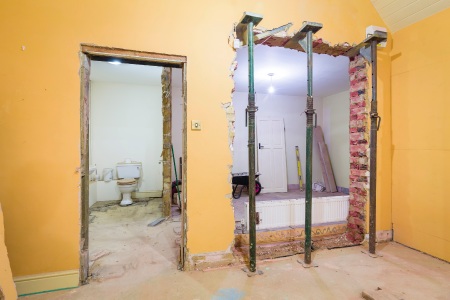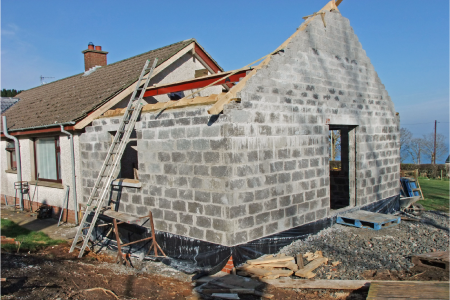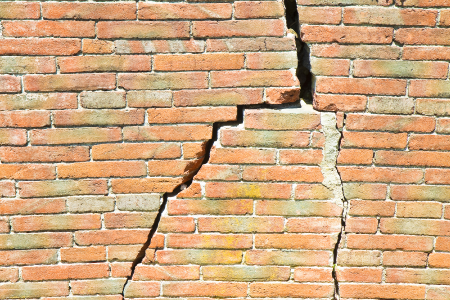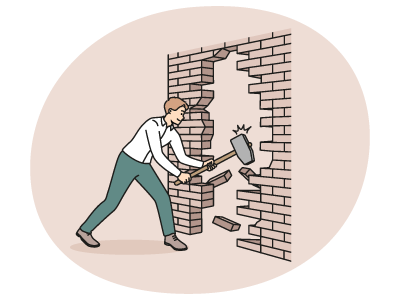Do I Need a Structural Engineer to Remove a Wall?
- Removing a load-bearing wall requires structural engineering expertise. A structural engineer will confirm what load the wall is bearing and advise how to remove it safely with necessary reinforcements, to ensure the stability of your home, during and after removal.
- Planning permission is generally not required for removing internal walls unless it alters the external appearance of your home. It's best to check with your local planning authority to confirm this.
- Consult with local authorities and involve a structural engineer to guide you through the building regulations process to ensure you're legally covered. All structural engineers will be trained to comply with building regulations.
- The cost of removing a wall averages between £1,000 to £3,000 but depends on whether it's load-bearing, its size, and additional factors like redecorating or electrical work.
Want to transform your home with a wall removal? Before you pick up the sledgehammer for an open-plan space or a larger bedroom, consider the structural implications and if you need a structural engineer's input.
What is a structural engineer?
A structural engineer specialises in ensuring buildings are safe and stable. They possess in-depth knowledge of building materials, construction methods, and structural mechanics. When removing a wall, especially a load-bearing one, their expertise is crucial to prevent structural damage and ensure the safety of your home.
Unlike architects who focus on design and aesthetics, or builders who carry out construction, structural engineers look after the building's structural integrity. They assess the existing structure, design solutions, and ensure compliance with building regulations.
Key responsibilities include:
- Structural assessment: Evaluating the home's structure to identify load-bearing walls and potential weaknesses.
- Design and calculations: Creating plans for reinforcing the structure after wall removal, including steel beams or supports.
- Building regulations: Ensuring the project complies with building regulations.
- Site inspections: Monitoring the work to ensure it's sticking to the approved plans.
- Client liaison: Providing clear explanations and guidance throughout the project.
Our experienced structural engineers can help with your load-bearing wall removal. They will provide calculations and drawings for the building contractors to follow and will work with you to get the project done safely and efficiently.
Load-bearing vs non-load-bearing wall
Load-bearing walls are the backbone of a building, supporting the weight of the structure above, including floors, roofs, and even external walls.
Removing a load-bearing wall without proper engineering and reinforcement can lead to severe structural damage or even complete collapse, compromising the entire building.
Non-load-bearing walls primarily serve as room dividers. They don't support the building's weight and can generally be removed without affecting the overall structure.
Identifying which type of wall you have is essential. Consulting a structural engineer to determine the load-bearing status of a wall is highly recommended before any removal work begins.
Why would you need to remove a wall?
Removing a wall can dramatically transform your living space, creating a more open and functional home. Here are some common reasons homeowners consider wall removal:
- Open-plan living: Combining kitchen, dining, and living areas for a modern and sociable space.
- Extensions: Removing an external wall to create an extension such as a conservatory or new kitchen.
- Space saving: Creating larger bedrooms or bathrooms to accommodate growing families or changing lifestyles.
- Improved natural light: Removing walls between rooms can increase natural light, creating a brighter and airier atmosphere.
- Architectural style: Some architectural styles, such as contemporary or minimalist, prioritise open-plan layouts.
Planning permission and building regulations
Understanding planning permission and building regulations is crucial when removing a wall, especially a load-bearing one. A structural engineer will be able to help with these.
Planning permission is generally not required for removing internal walls unless the project significantly alters the external appearance of your home. However, you should check with your local planning authority to confirm.
Building regulations are crucial when removing load-bearing walls. These regulations ensure the safety and structural integrity of your home. A structural engineer will be trained to comply with building regulations and help to obtain necessary approvals.
A structural engineer could also assist with:
- Party wall agreement: If you're knocking down a wall which adjoins a partition wall with your neighbour's property, you'll need a party wall agreement before starting work. SAM's RICS-accredited surveyors can help you with this, and a structural engineer isn't necessary.
- Building control approval: You'll typically need building control approval before starting work. Structural engineers can help to prepare and submit the required documentation.



How do I know if a wall was removed safely in the past?
If you're buying a property which has had a load-bearing wall removed, it should have a building regulations certificate to confirm the work is compliant. If the certificate is missing, you should have a structural engineer assess the work to see if it's safe and suitable for a letter of regularisation certificate.
If the seller refuses to cooperate you may be better off pulling out, rather than risk buying a property which could be dangerous, illegal, and unmortgageable.
Signs of a potentially unsafe wall removal:
- Visible cracks: Look for cracks in walls, ceilings, or floors, especially near the removed wall.
- Uneven floors: Sagging or uneven floors could indicate structural issues.
- Door or window misalignment: Doors or windows that don't close properly might indicate structural movement.
Checking for building regulations compliance:
- Building control certificates: Request building control certificates from the previous owner to verify that the work was approved and carried out safely.
- Structural engineer report: A structural engineer can assess the property's structural integrity if certificates are unavailable. This will involve a detailed inspection and invasive investigations.
- Regularisation: If building regulations weren't followed, you might need to regularise the work. This involves applying for retrospective planning permission and potentially undertaking remedial work to ensure the property's safety.
Our structural engineer will attend the property to inspect the unauthorised works for compliance with Building Regulations - Part A: Structure.
This is an intrusive survey. The report will:
- Confirm that the works appear compliant and simply need to be signed off by building control.
- Outline any works required to make the work structurally compliant before bringing a building control inspector in to grant the letter of regularisation.
- Confirm that the work would need to be completely undone or redone to meet building regulations.
Pros and cons of removing a wall
Pros
- Enhanced space and flow: Creating open-plan living areas for a modern and sociable atmosphere.
- Increased natural light: Improving the overall brightness and ambience of your home.
- Architectural flexibility: Adapting your home to changing lifestyles and preferences.
- Potential property value increase: A well-executed wall removal can enhance your home's market value.
Cons
- Structural implications: Removing a load-bearing wall requires careful planning and expert advice to maintain structural integrity.
- Cost: The project can be expensive, including materials, labour, and potential structural reinforcement.
- Disruption: Wall removal and subsequent renovations can be messy and time-consuming.
- Planning permission: You might need planning permission, depending on the nature of the work.
- Unexpected challenges: Discovering hidden issues like electrical wiring or plumbing can add to costs and delays.
How much does it cost to remove a wall?
The cost of removing a wall varies depending on whether it's load-bearing, the wall's size, and the project's complexity.
Non-load-bearing walls: Removing a non-load-bearing wall typically costs between £1,000 and £2,500, including labour, materials, and waste disposal. For example, you might want to create an open-plan kitchen and dining area.
Load-bearing walls: Removing a load-bearing wall is more complex and expensive. Expect to pay between £1,500 and £3,000 or more, including the cost of a structural engineer, steel beams, and additional building work. For example, you might want to knock down the wall between your kitchen and dining room, which supports the wall between your upstairs bedrooms, which in turn supports the roof. You may have to install an RSJ to carry the weight of the floor and wall above and build strong block columns to carry the RSJ. There may be further work required to reinforce the foundations below. All of this, as well as subsequent re-finishing, will add to the overall cost.
Factors affecting cost
- Larger walls naturally cost more to remove.
- Walls in hard-to-reach areas might incur additional costs.
- Removing plaster, redecorating, and dealing with electrics or plumbing can increase the overall cost.
- Costs can vary depending on your location, availability, and demand - labour and materials costs differ from region to region.
- The complexity of the structural work required can also impact the cost. The more structurally significant the wall is, the more complex reinforcements will be required to redistribute the weight.
Note: While it's possible to incorporate a kitchen into a space where a load-bearing wall once stood, it often requires careful planning and structural reinforcement. Always consult with a structural engineer before proceeding.
Jack is our resident Content Writer with a wealth of experience in Marketing, Content, and Film. If you need anything written or proof-read at a rapid speed and high quality, he's your guy.
Caragh is an excellent writer and copy editor of books, news articles and editorials. She has written extensively for SAM for a variety of conveyancing, survey, property law and mortgage-related articles.










